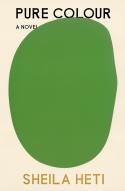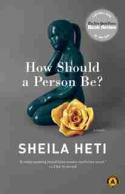Sheila Heti never shies away from the big questions. The title of her 2010 novel, for example, asked How Should a Person Be?
Where that bold work of autobiographical fiction merged memoir, philosophy and art to portray the search for meaning big and small—Does life have meaning? Why do I care about petty things?—it was an inward-looking work that focused on grounded struggles.
 The Canadian writer's latest work may be even more ambitious. Pure Colour is an elliptical foray into the mythology of metaphysics. It is a true work of art in that it seeks to express feelings and ideas that have not yet been tamed and familiarized by language. So doing the critics work - corralling, limiting, boxing in a work so we describe and explain it to someone else—can never do this justice.
The Canadian writer's latest work may be even more ambitious. Pure Colour is an elliptical foray into the mythology of metaphysics. It is a true work of art in that it seeks to express feelings and ideas that have not yet been tamed and familiarized by language. So doing the critics work - corralling, limiting, boxing in a work so we describe and explain it to someone else—can never do this justice.
Still, we have to say something. Here’s a description, from the publisher, which describes Pure Colour as "a contemporary bible, an atlas of feeling and a shape-shifting epic.”
Here we are, just living in the first draft of creation, which has been made by some great artist, who is now getting ready to tear it apart. In this first draft of the world, a woman named Mira leaves home to study. There, she meets Annie, whose tremendous power opens Mira’s chest like a portal―to what, she doesn’t know. When Mira is older, her beloved father dies, and his spirit passes into her. Together, they become a leaf on a tree. But photosynthesis gets boring, and being alive is a problem that cannot be solved, even by a leaf. Eventually, Mira must remember the human world she’s left behind, including Annie, and choose whether or not to return.
In his New York Times review, Dwight Garner asks, “Where is Heti going with this?”
His answer: “It’s complicated. Pure Colour runs its readers along a borderline of substance and hallucination. You sense her doing several things at once. … One, she is making room to talk about ideas that interest her—the mystery of consciousness, ego versus the true self, inklings of the divine, the nature of criticism, the kibbitzing mind versus what Emerson called “the wise silence.”
 Two, she is niftily confounding expectations. Heti’s recent novels, Motherhood and How Should a Person Be? have been placed in a box labeled, drearily, autofiction. “Pure Colour” breaks that box. This is a writer who—for the moment, at any rate—wishes to be less rather than more understood.
Two, she is niftily confounding expectations. Heti’s recent novels, Motherhood and How Should a Person Be? have been placed in a box labeled, drearily, autofiction. “Pure Colour” breaks that box. This is a writer who—for the moment, at any rate—wishes to be less rather than more understood.
Jennifer White agrees with Garner is her Vulture review: “Pure Colour is an almost incoherent novel, a story unfolding in a world at times illuminated only by Christmas lights. Its strangeness might tire readers used to Heti’s more grounded and linear fiction. The reward is that you could actually emerge feeling better. ‘My basic premise is that in life, you live forever,” the spirit of Mira’s father tells her, “because as soon as you die, you don’t realize you’re dead, so you’re kind of always alive, so the thing is, you shouldn’t worry about yourself.’”
Pure Colour is a challenging read – its 216-pages demand immense focus. But it is also heartfelt and beautiful, fresh and alive. Heti is challenging herself—asking big questions of herself and her writing as she asks those of the world. Bravo!
- Read an excerpt from Pure Colour
- Watch Heti discuss her novel
- Visit Heti’s official website
Sheila Heti’s Top Ten List
1. The Picture of Dorian Grey by Oscar Wilde (1891).
2. Two Serious Ladies by Jane Bowles (1943).
3. The Screwtape Letters by C. S. Lewis (1942).
4. The Neapolitan novels by Elena Ferrante: My Brilliant Friend (2012), The Story of a New Name (2013), Those Who Leave and Those Who Stay (2014), and The Story of a Lost Child (2015).
5. Anna Karenina by Leo Tolstoy (1877).
6. Crime and Punishment by Fyodor Dostoevsky (1866).
7. Faust by Johann Wolfgang von Goethe (Part One, 1806; Part Two, 1831).
8. Either/Or: A Fragment of Life by Soren Kierkegaard (1843).
9. The Hour of the Star by Clarice Lispector (1977).
10. The I Ching (Book of Changes).